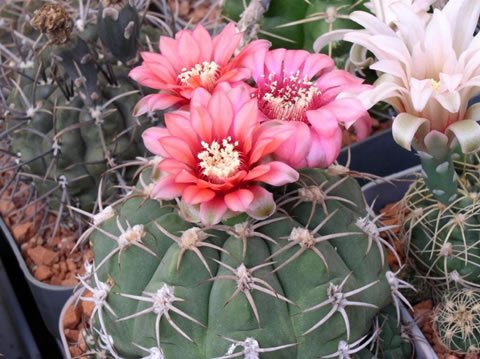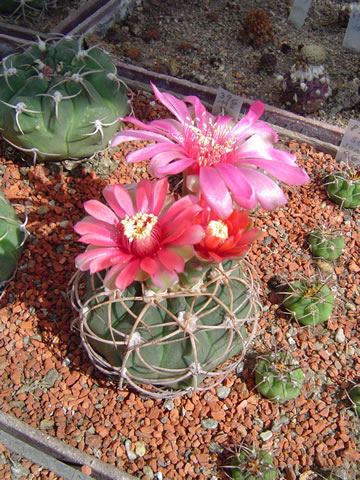Blätter für Kakteenforschung 1934
Tělo jednotlivé, matně světle šedozelené, asi 11 žeber až 2 cm širokých, ostrá zadní hrana, nad areolami vystouplé hrbolce, pod nimi ostrá příčná rýha.
Okrajové trny 5, průsvitné, šedé, málo zahnuté, na úzkých podlouhlých šedých areolách.Vlna areol žlutavá. Střední trn chybí.
Květy svítivě vínově červené, velké, až 5 cm dlouhé, šupiny růžově lemované. Plod světle zelený, mírně ojíněný.
Domovina: Argentina, Mendoza.
Autor popisu Backeberg pravděpodobně rostlinu koupil v Argentině a údaje o nalezišti čas od času měnil, a ani dnes ještě nikdo neví, kde vlastně rostlina rostla, nebo zda jde o kultivar vypěstovaný v Jižní Americe. Backeberg sám napsal, že barva květu může varírovat až po temně lososovou. Ritter ve svém díle Kakteen in Südamerika uveřejnil fotografii domnělého Gymn. oenanthemum s jeho číslem FR 437. I z dalších nálezů označených původně jako Gymn. oenanthemum se vždy vyklubalo něco jiného. Variabilita jedinců v kultuře je pochopitelná, protože od roku popisu, tedy 1934, nebyly rostliny ani semena dovezeny. Jedinci mají občas i střední trny a dá se předpokládat, že variabilita rostlin se bude s přibývajícím časem zvyšovat.
Dr. Rudolf Slaba v českém časopisu Kaktusy 2011 číslo 2, strany 39 – 44, se věnuje tomuto taxonu a za Gymn. oenanthemum považuje Gymn. carminanthum popsané Borthem a Koopem v KuaS-u roku 1976. Tuto kombinaci navrhli angličtí taxonomové Hunt, Taylor a Charles v The New Cactus Lexicon 2006. Základním kamenem k této synonymii je skutečnost, že Gymn. oenanthemum Backbg. nebylo od popisu v BfK (Blätter für Kakteenforschung) roku 1934 znovu nalezeno, a tak někteří dnešní znalci rodu tvrdí, že jde o Gymn. carminanthum. Nevím nevím, zda je takové srovnání správné, a dost a dost o tom pochybuji. Dle mého názoru tato synonymie není to „pravé ořechové“. To však za toho předpokladu, když budu s Gymn. carminanthum srovnávat rostliny Gymn. oenanthemum skutečně sensu Backeberg, tak jak odpovídají nejen jeho popisu, ale i vyobrazení a také rostlinám původem od Backeberga. Sem již nepatří rostliny pěstované jako Gymn. oenanthemum v některých českých sbírkách, které se již blíží jak tělem, otrněním, tak i květy Gymn. carminanthum. Staré Bakovo oenanthemum má tělo světleji zelené, tak jak je přesně uvedeno v popisu matně světle šedozelené, zdaleka nemá tak tmavé tělo jako Gymn. carminanthum, otrnění je zcela jiné než jaké má Gymn. carminanthum. Květy Gymn. oenanthemum jsou popsány jako svítivě vínově červené, záleží také na tom co tím autor Bak myslel, všelijakých červených vín je řada odstínů a také záleží kolik vína při popisu vypijete, ovšem jedinci Gymn. oenanthemum sensu Backbg. měly květy vždy světle růžové, stárnoucí květy přecházejí do křídově růžové (pastelově růžové), a s uváděným odstínem u Gymn. oenanthemum „temně lososovou“ se u Gymn. carminanthum nebo Gymn. tillianum vůbec nesetkáte, zato na druhé straně se nikdy nesetkáte u Gymn. oenanthemum s karmínově červenou barvou jako u Gymn. carminanthum a již vůbec ne s krvavě nebo tmavě červenou jako u Gymn. tillianum. Považuji za typickou formu Gymn. oenanthemum sensu Backeberg odpovídající i vyobrazení v BfK rostliny pocházející ze sbírky Ferdinanda Plesníka v Olomouci a je mým nedostatkem který musím napravit - vybavit tuto práci tímto snímkem. Zatím se můžete na takovou typickou rostlinu podívat na snímku „Gymn oenanthemum 3 květy na 1 rostlině……“ kde je „Gymn oenanthemum Pk“ jak ji označuji (Pk=Plesník) vlevo nahoře ( 5 trnů – ano, ovšem 3 silnější trníky do písmene T a dva malé trníky jakožto vrchní pár směřující do stran). Jde o starou známou skutečnost, že Backeberg koupil tyto rostliny s dalšími gymnokalycii u obchodníka Stümera v Buenos Aires. Kdo a kde tyto rostliny sbíral, již asi nezjistíme, nebo zda přišly na svět v nějakém jihoamerickém zahradnictví. Ale potom co bylo s čím sprášeno??? Jsem přesvědčen že brzy přijde doba, kdy naši botaničtí experti pracující na univerzitách budou schopni podle vědeckých analýz zjistit, kdepak a kdopak jsou ti tajemní rodičové tak jak je to již možné u člověčenstva. A asi se budeme mnohdy divit. Každopádně Gymn. oenanthemum, pokud nebude znovu nalezeno v přírodě, nepovažuji za totožné s ohledem na uvedené skutečnosti s Gymn. carminanthum, ale spíš za povedený hybrid, barvou květu připomínající Gymn. denudatum cv pažoutianum neboli hybr. Jan Šuba. Tomu napovídá i produkce semen Gymn. oenanthemum: semen je v plodu málo a v jednom semeníku najdeme dva typy semen. Jedna semena jsou hnědočerná, vyzrálá, vzezřením snad vitální, druhá semena jsou zřetelně světlejší a nevyvinutá, jakoby nedonošená, objemem menší. Tento druhý typ semen jsem vždy po sklizni jakožto semena invalidní a pochybná vždy odstraňoval. Bavili jsme se o tom několikrát i s p. Franzem Striglem při soukromých několikahodinových sympoziích v Kufsteinu. Pravděpodobně stejného hybridního původu jsou s vysoce úspěšným odhadem i Gymn. rauschii a Gymn. schuetzianum. Takovým závěrům nasvědčuje i skutečnost, že taxon popsaný jako Gymn. nigriareolatum v carmineum (viz informace tam) se vyskytuje poblíž potoků tekoucích z hor, kam mohli donést semena červenokvetoucích taxonů ptáci či nějaký ten hmyz. Z výsevů tohoto taxonu pak získáte jedince kvetoucí špinavě růžově (opět pochybný znak), ale také jedince kvetoucí bíle. Jde zde tedy zjevně o přírodní výpěstek s neustálenými znaky v ranném stupni vývoje. Totéž platí naopak i o Gymn. catamarcense acinacispinum, kterýžto taxon je vlivem houbových chorob v domovině na vymření, a který vám zase naopak může vykvést červeně.

Gymn. oenanthemum, foto Rudolf Frélich

Gymn. oenanthemum 3 květy na 1 rostlině, nejstarší květ největší a nejsvětlejší
Gymn. oenanthemum – summary:
Flowers shiny winered, big, to 5 cm long, scales pink margined. Fruit light green, slightly covered with hoar frost.
Homeland: Argentina, Mendoza.
The author of the description had probably bought one plant in Argentina and the data about the finding place has been changed with a time, and nobody knows even today where the plant had grown, or if it had been some cultivar grown in South America. Backeberg has written himself that flower colour can vary as to dark salmon. Ritter has published in his Kakteen in Südamerika the photo of the supposed Gymn. oenanthemum with his number FR 437. It has been always grown something different even from the other finds marked originally Gymn. oenanthemum. It is very comprehensible the variability of the specimens, because neither plants and nor seeds have been imported since the year of the description 1934. Some specimens have sometime even central spines and itis possible to presuppose that plant variability will be greater during a time.
Dr Rudolf Slaba writes about the taxon in the Czech journal Kaktusy 2011 No 2, pages 39 – 44, and he holds the name Gymn oenanthemum also for Gymn carminanthum described by Borth and Koop in KuaS in 1976. This combination was proposed by the English taxonoms Hunt, Taylor and Charles in the New Cactus Lexicon 2006. The basic idea for this synonymy is the reality that Gymn oenanthemum Backbg has not been discovered again since the description in BfK (Blätter für Kakteenforschung) in the year 1934, and so some today experts of this genus means that it is Gymn carminanthum. I do not know – and I do not know again if the comparison like this is right and I am very very in doubt about it. This synonymy is not quite correct in my opinion. However, I must presuppose that I will compare with Gymn carminanthum the plants of Gymn oenanthemum really sensu Backeberg as they agree not only with his description but also with his picture and also with the plants with the origin from Backbg. The plants growing like Gymn oenanthemum in some Czech collections which are close with their body, spination and flower to Gymn carminanthum, belong not here yet. The old Back´s Gymn oenanthemum has the body more light green as it is correctly written in the original description „dull light graygreen“, it has not so dark body like Gymn carminanthum at all, the spination is quite different than on Gymn carminanthum. The flowers of Gymn oenanthemum are described like shining wine red, it is a question what had the author Bak in his mind, various shades of red wines are plenty and it is also a question how many wine the author can drink if he is doing a description. However, the specimens of Gymn oenanthemum sensu Backbg have the flowers always light pink, becoming old to chalky pink (pastel pink) and mentioned shade at Gymn oenanthemum „dark salmon“ we can not see at Gymn carminanthum or Gymn tillianum at all and on the other hand you will never see on Gymn oenanthemum carmine red flowers as it is usual on Gymn carminanthum and not with blood or dark red flowers as on Gymn tillianum at all. I hold as the typical form of Gymn oenanthemum the plants originated from the collection of Mr Ferdinand Plesník in Olomouc agreeing also with the picture in the BfK and it is my wrong that a picture is not in this work. I must put it right. For the time being you can see the typical plant of Gymn oenanthemum in the picture „Gymn oenanthemum 3 květy na 1 rostlině…….“ Where is „Gymn oenanthemum Pk“ as I have it marked (Pk = Plesník) left up (5 spines – yes, 3 rather hard spines in the shape of the letter T and two little spines as the upper pair to the sides directing). It is the old known history that Backeberg had bought the plants with other gymnos from the cactus businessman Stümer in Buenos Aires. Who and where collected those plants, we will probably not find, or if they had come into existence in some argentinian nursery. However, what had been which pollinated with? I am sure that it will be soon a time when our botanical experts working at universities will be able to find with scientific analyses who are the mystery parents as it is already possible with people. Maybe we will be often surprised. In any case, if Gymn oenanthemum will not be find in the nature, I hold it not for the identical with Gymn carminanthum with regards to the mentioned realities but more for well made cultivar whose colour of the flower remembers Gymn denudatum cv pažoutianum alias hybr Jan Šuba. It is evident also from seeds production Gymn oenanthemum: the seeds are only few in one fruit and we can find two types seeds in one fruit. The first seed type is brownblack, ripe, maybe vital on the first sight; the other seeds are evidently lighter and not well developed, as if misscarried, smaller in HL capacity. I had always given back the second type of the seeds like the invalid and doubtful ones. We had several times spoken about it with Mr Strigl at the private several hours symposiums in Kufstein. Gymn rauschii and Gymn schuetzianum have probably the same hybrid origin. It is also evident the reality that the taxon described as Gymn nigriareolatum v carmineum (see information there) grows close the brooks running of the mountains and there seeds of the red flowering taxa can be carried there by birds or some insects. We have got from the sowing of Gymn nigriareolatum v carmineum the specimens with dirty pink flowers (doubtful sign again), however, also the specimens with white flowers. So it is evidently the natural product with the inconstant signs in the early evolution level. The same it is valid also for Gymn catamarcense acinacispinum which on the other hand can flower with red colour and which is moribund in the nature for the sake of the fungus diseases.
